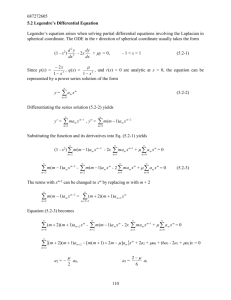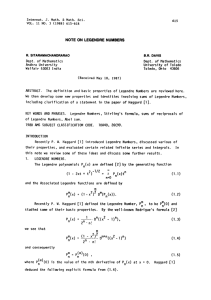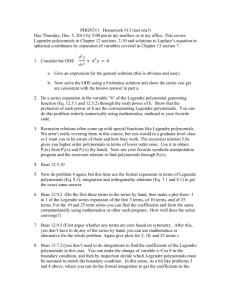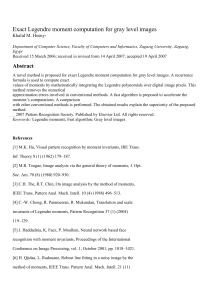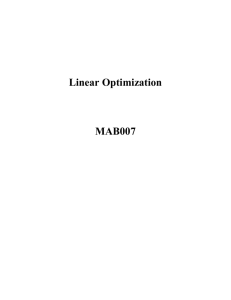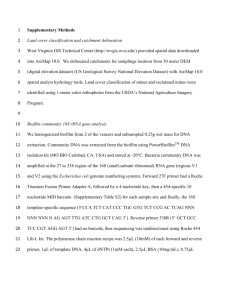NUMBERS OF THE SECOND KIND
advertisement
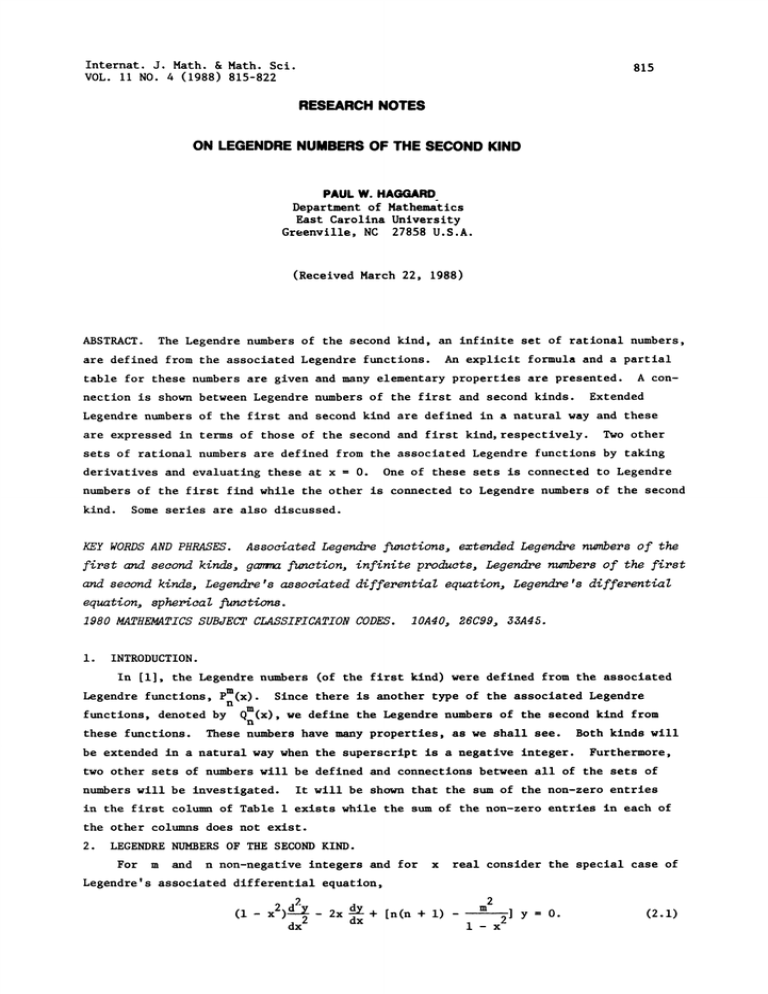
Internat. J. Math. & Math. Sci. VOL. Ii NO. 4 (1988) 815-822 815 RESEARCH NOTES ON LEGENDRE NUMBERS OF THE SECOND KIND PAUL W. HACARD Department of Mathematics East Carollna University Greenville, NC 27858 U.S.A. (Received March 22, 1988) ABSTRACT. The Legendre numbers of the second kind, an infinite set of rational numbers, are defined from the associated Legendre functions. An explicit formula and a partial A con- table for these numbers are given and many elementary properties are presented. nection is shown between Legendre numbers of the first and second kinds. Extended Legendre numbers of the first and second kind are defined in a natural way and these are expressed in terms of those of the second and first kind, respectively. Two other sets of rational numbers are defined from the associated Legendre functions by taking derivatives and evaluating these at x 0. One of these sets is connected to Legendre numbers of the first find while the other is connected to Legendre numbers of the second kind. Some series are also discussed. KEY WORDS AND PHRASES. Associated Legendre functions, extended Legendre numbers of the first and second kinds, gamma function, infinite products, Legendre numbers of the first and second kinds, Legendre s associated differential equation, Legendre s differential equation, spherical functions. lgBO MATHEMATICS SUBJECT CLASSIFICATION CODES. IOA40, 26Cg, 3A45. i. INTRODUCTION. In [I], the Legendre numbers (of the first kind) were defined from the associated Legendre functions, P:(x). functions, denoted by these functions. Since there is another type of the associated Legendre Q:(x), we define the Legendre numbers of the second kind from These numbers have many properties, as we shall see. be extended in a natural way when the superscript is a negative integer. Both kinds will Furthermore, two other sets of numbers will be defined and connections between all of the sets of numbers will be investigated. It will be shown that the sum of the non-zero entries in the first column of Table i exists while the sum of the non-zero entries in each of the other columns does not exist. 2. LEGENDRE NUMBERS OF THE SECOND KIND. For m and n non-negative integers and for x real consider the special case of Legendre’s associated differential equation, (i- x 2. dx2 2x + [n(n + i) i- x 2 y o. (2.1) 816 P.. HAGGARD The solutions of (2.1) are spherical functions corresponding to the rotation group of When 3-dimensional space. 0, (2.1) becomes m x2) d2 (1 2x dx dy dx / n(n 1)y / (2 2) 0 Legendre’s differential equation. The fundamental system of solutions (2.2) is given by two kinds of functions that we denote by P (x) and Qn(X) see [2]. These have many forms, two of which are, see [3], and is known as of n <. For pm(x)n m and n! 2 1 Qn(X) # 0, dn(x2 i P (x) n i- Pi-l(x) Pn-i(x) i iffil -l<x<l. the solutions of (2.1) are denoted by the associated Legendre functions Q:(x) where these can be expressed in the forms Q:(x) x O. Definition i. For 2 m2 dmPn (x) (-l)m(l x (-l)m(l x2) dmQn(X) m d (2.4) dx In [i], the Legendre numbers for (2.3) n P (x) log l+x n x Pffi(x)n Pro(x) n l)n n dx of the first kind) were defined as the values of A similar definition is made for Legendre numbers of the second kind. m and n non-negative integers, the Legendre numbers of the second kind are 0 for m,n of the same parity m Q:(0) for m,n of different parity. From this definition and (2.4) one can obtain the explicit formula, see [3], _ Qnm= [0 l for m,n of the same parity m+n _2m-i / sin(-T) r(+i) r(n-2m+2) for the Legendre numbers of the second kind. Q m,n of different parity Note that the second part of (2.5) could m,n of the same parity if m n but not for m n + 2. m Considering Table 1, it seems reasonable that we define to be 0 for m,n of the same parity so that if a diagonal or alternate diagonal of the table has a zero on be used to define for Qn it all entries on it are zero. Recall the gamma function is not defined for zero or negative integers. By definition show that for n m Qn 0, an integer, for m,n is a non-zero integer for I, m won’t classify n i. It is easy to n 0 and also There are other entries in Table i that are integers but we them here. but not integers. m,n of the same parity. of different parity and One could classify those values of Q that are rational LEGENDRE NUMBERS OF THE SECOND KIND Qo 817 3 1 0 -1 0 -2 0 -24 0 -720 0 -i 0 2 0 8 0 144 0 5760 0 2 0 -8 0 -48 0 -1152 0 2 3 0 -8 0 48 0 384 0 11520 0 48 0 -384 0 -3840 0 3840 0 46080 0 -46080 0 8 0 8 15 0 16 0 -384 0 0 16 5 0 -128 0 3840 16 35 0 128 5 0 1280 0 128 35 0 256 0-46080 0 645120 0 0 645120 0 -15360 128 315 TABLE I. LEGENDRE NUMBERS OF THE SECOND KIND SOME BASIC PROPERTIES. Many of the following properties of the Legendre numbers of the second kind can be observed from Table 1 and can be easily proved using (2.5). The non-zero entries in the first row are Q -(m i)!, m (3.1) I, m odd. The entries on the main diagonal are (3.2) O, n > 0. For m n 1, we have 0 Q1 -i n-i (-l)n-2.4.6---(2n [Qn 2), n (3.3) 2. The entries adjacent to the main diagonal and on slant lines through it are equal. Thus, n Qn-l’ n >_ I. (3.4) Each entry can be expressed in terms of one in the first column or first row, respectively, as (-1)m(n + m Qn m 1)(n + m (-l)m+l(n + m- 3).-.(n m + l)Qn_m, n > m m-n m > n. l)(n + m- 3).--(m- n + I)Q0 (3.5) (3.6) Entries in the first row are connected to those in the first column by m Q0-- m(m 2)(m 4).--(-m + 2) m’ (3.7) 818 P.N. HAGGARD and, more generally, m Qn (m n) (m 2) (m n 4) n (n 2)Qm + m (3.8) m > n. Each entry can be expressed in terms of the one just above and to the left, Just above and to the right, second one above, and second one to the left, respectively, as m Qn =-(n + m- m n-m’ n+m- m+l Qn PROOF OF (3.12). n and and n m --> 2 (3.9) 1 Qmn-2 mn (3.n) n > 2 + m >_ of the same parity, then n (3.12) 2. and are of 2 m Thus the two sides of (3.12) have value 0 and the result holds. the same parity. Assume If n (3.lo) m n + i)<-i1 m are of different parity and m >_ 2. Then n m- 2 and are of different parity and by (2.5) and properties of the gamma function, we have, -(n+m-l) m-2 (n-m+2)Qn -(n+m-1) (n-m+2) (n.-mJ-,4 r (3.13) m Qn" which simplifies easily to Thus, (3.12) is proved. The non-zero entries of Table 1 are given by the explicit formula n+l (m-m_-l) (-!) (m-n)(m-n+2)-.-(m+n-2) m + (3.14) n odd. As a special case of (3.14), the non-zero entries in the first column are (n-l) (-n)(-n+2)-.-(n-2) Consider an alternate diagonal of Table I. (3.15) n odd. Starting with for n odd, the other entries on this alternate dlagonal are obtained in order by multlplylng by n, n- 2, n- 4,---,1, -1, -3,--.,-(n- 2) in this order. For example, 0 n n-i nQ Q0 =-(n 2) -i n’ -2 (n-i An entry can be expressed in another way, see (3.5), in terms of an entry in the 2) "’’’ QI first column as < An interesting result (n + m)(n + m 2).--(n m + 2)+n, m_> i. (3.16) involving products of numbers symmetric with respect to a given position in Table i is -i Q+i Qn-i n An+i qn n- i >_ O. (3.17) LENGENDRE NUMBERS OF THE SECOND KIND 4. 19 A CONNECTION BETWEEN LEGENDRE N-UMBERS OF THE FIRST AND SECOND KINDS. Recall, see [i], that the Legendre numbers of the first kind are given by the ex- plicit formula 0, m pm + n odd 0, m > n n-m n (-1)2 (n + m)! + m 2n()!()’ n even, m_< (4.1) n. One can easily verify that 0 pl Qn -i, n odd, n > I. (4.2) We next define the extended Legendre numbers of the first find and obtain a result more general than (4.2). p-m A further extension to -n is possible but will not be pre- sented here. For Definition 2. and m non-negatlve integers with n r(n+m+l) m p-m+l n . p-m+l Q: m n odd, -I, m > 0, n > I, m n (4.3) < n. Now, p- (m-l) n n-m+l m+. )r (-2)m-1,/- sin(T (m++l) (_l)m-l(n_m+l)! (n+m-1) (,n-r+2) r(#l) (n-l),, have 2 -(-i) 2isln( ) (n-l) p-l r Since + n Using (2.5) and Deflnlton 2, we can prove that for Qn n, (-l)mr (n-re+l) pro. p-m n PROOF OF (4.3). m (-l) -n+m-l- 2n t., 2 (n+--l) (n-2m,l) (4.4) we n-i 2 2hi (-l) Since r( and there are 2m-l sin ( ) (=-I) (4.5) 2 --1 n-l 2 factors in each bracket (4.5) reduces to n-i (4.6) Note that for n+m=2k+l, k even sin( =) [l’ CI, k odd n+m-i (-1) 2 C (-1)k I, k even ’-1, k odd (4.7) P.W. HAGGARD 820 Using (4.?) in (4.6), the proof of (4.3) is complete. p-m n A table of the numbers would lead to many properties of these numbers. How- ever, we will not examine these numbers further here. 5. NUMBERS RELATED TO LEGENDRE NUMBERS. kind can be extended as were those of the m will not be presented here. The extention to second The Legendre numbers of the Qin first kind, see Definition 2. Definition 3. For m and n non-negative integers 0 for m and n of the same parity 0 for n odd, m even (-l)mr (n-re+l) ---;"-"’lnnrr+/-, ^m n zor n even, -,3,5, m These extended numbers can be obtained explicitly by replacing with m ,n-l. -m in (2.5) as 0, m,n of the same parity =i -2-m-l- even_m+n O, n odd, m sin (---- )r( r, 1,3,5, --,n-1. n even, m (5.1) 2 An argument similar to that given for (4.3) would show that (5.1) is equivalent to Definition 3. A result similar to (4.3), with pro+l=-I, Q-re. n n m replaced with n even, m -m, (5.2) 1,3,.--,n-i is easy to prove by evaluating the left side of (5.2). Another interesting set of numbers is obtained by taking the first derivatives of the associated Legendre functions and evaluating these at d Pnm(O) 2m+l dx r m (n-l) r (_r_) Now, we define the set of numbers m for Pn’ + x O. From [3], (5.3) n odd, n > i, m < n. m,n non-negative integers by 0, m>n 0, m m Pn + [d Prim(o) dx n even (5.4) m / n odd, n _> i, m_< n. A connection between these numbers and the Legendre numbers of the first kind is m Pn (-1) npm+l n (5.5) The proof of (5.5) consists of evaluating both sides of the equation. Proceeding in the same way for the functions gers, from [3], with m + n even or m d (0) dx + 2m/’’ Q(x) with m,n non-negative inte- n odd with m < n, ( )rt.n+m+2. 2 r (n-+l) cos (5.6) 821 LENGENDRE NUMBERS OF THE SECOND KIND For m and non-negatlve integers we define the set of numbers n 0, m + n odd m qn d Q(0) m dx + n even. An almost trivial argument shows that these numbers are connected to the Legendre numbers of the second kind by m+l m 6. (5.8) -Qn- SOME SERIES OF LEGENDRE NUMBERS. Our aim here is to show that the sum of the non-zero entries in column one of Table i exists while those of the other columns do not exist. The work will involve in- finite products and the reader is referred to [2] and [6] for short introductions to this topic and to [6] for the following theorem. THEOREMI. the series [ an --> 0, If each then the product n=l(l a n converges if and only converges. a n n= 1 Consider the sum of the non-zero entries in the first colunm of Table I. This sum can be expressed as the infinite series [ Q2k+l" (6.11 k=0 From (3.15) with n 2k + a general term of this series can be simplified to i, -i, a2k+l k 0 (-l)k+12k(2k-2)---2 (2k+l) (2k-i)---3’ (6.2) k > 1 Clearly the series is alternating with decreasing positive terms. Furthermore, the limit of a general term exists and is non-negative since this sequence is a decreasing sequence and is bounded below by 0. If we show that 2k(2k-2)---2 (2k+l) (2k-l)--" 3 _m (6.3) O, the series converges by the alternating series test. Now, the left side of (6.3) can be expressed in the equivalent forms klll: 2k 2k+l 1 kll: (I z-,-.--r"r-’)" (6.4) Since the series clearly diverges, Theorem i gives that the infinite products in (6.4) diverge. Therefore, (6.3) holds An argument using asymptotic functions might prove in- this and the remarks after (6.2), this divergence is to zero. and the series (6.1) converges. teresting. From What the series in (6.1) converges to is an open question. P.. IGGARD 822 The product of all the odd positive integers divided by the product of all the even positive integers can be expressed in the forms 2k+l i kl 2--- kl(l + ). This infinite product can be shown to diverge to For i > 0, (6.6) +. the series involving the non-zero entries in the other columns of Table i, " k=0 Q2k+l (6.7) _2i-i 2k diverge because the limit of the nth terms is not zero. This is easily seen by ex- pressing a general term in terms of an entry in the first column using (3.16). REFERENCES On Legendre Numbers, International Journal of Mathematics and Mathematical Sciences, Volume 8, Number 2, 1985, 407-411. i. HAGGARD, P.W. 2. RAINVILLE, E.D. 3. IYANAGA, S. and KAWADAY, Y., Editors. Enclopedic Dictionary of Mathematics, The MIT Press, Volumes i and 2, 1980. 4. HAGGARD, P.W. Special Functions, The Macmillan Company, New York 1960. Some Applications of Legendre Numbers, International Journal of Mathematics and Mathematical Sciences, (to appear). Some Further Results on Legendre Numbers, International Journal of Mathematics and Mathematical Sciences, (submitted). 5. HAGGARD, P.W. 6. APOSTOL, T.M. Mathematical Analysis, Addlson-Wesley, Reading, Massachusetts, 1957.
